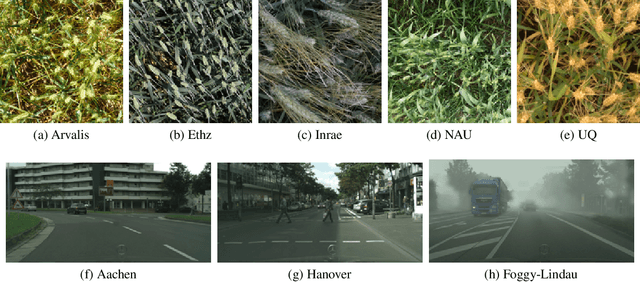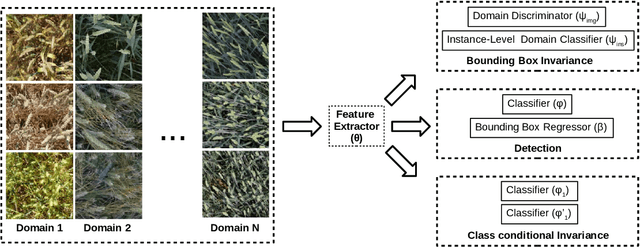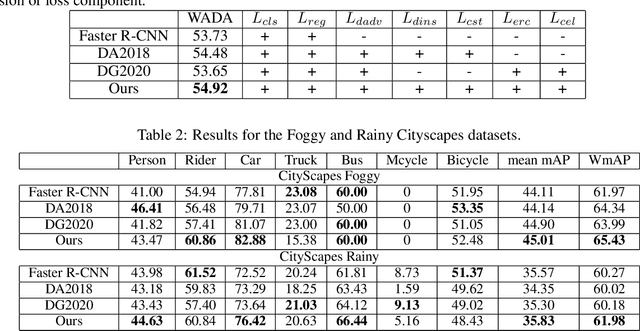Petra Bosilj
Multispectral Fine-Grained Classification of Blackgrass in Wheat and Barley Crops
May 03, 2024Abstract:As the burden of herbicide resistance grows and the environmental repercussions of excessive herbicide use become clear, new ways of managing weed populations are needed. This is particularly true for cereal crops, like wheat and barley, that are staple food crops and occupy a globally significant portion of agricultural land. Even small improvements in weed management practices across these major food crops worldwide would yield considerable benefits for both the environment and global food security. Blackgrass is a major grass weed which causes particular problems in cereal crops in north-west Europe, a major cereal production area, because it has high levels of of herbicide resistance and is well adapted to agronomic practice in this region. With the use of machine vision and multispectral imaging, we investigate the effectiveness of state-of-the-art methods to identify blackgrass in wheat and barley crops. As part of this work, we provide a large dataset with which we evaluate several key aspects of blackgrass weed recognition. Firstly, we determine the performance of different CNN and transformer-based architectures on images from unseen fields. Secondly, we demonstrate the role that different spectral bands have on the performance of weed classification. Lastly, we evaluate the role of dataset size in classification performance for each of the models trialled. We find that even with a fairly modest quantity of training data an accuracy of almost 90% can be achieved on images from unseen fields.
Neural Fields with Hard Constraints of Arbitrary Differential Order
Jun 15, 2023



Abstract:While deep learning techniques have become extremely popular for solving a broad range of optimization problems, methods to enforce hard constraints during optimization, particularly on deep neural networks, remain underdeveloped. Inspired by the rich literature on meshless interpolation and its extension to spectral collocation methods in scientific computing, we develop a series of approaches for enforcing hard constraints on neural fields, which we refer to as \emph{Constrained Neural Fields} (CNF). The constraints can be specified as a linear operator applied to the neural field and its derivatives. We also design specific model representations and training strategies for problems where standard models may encounter difficulties, such as conditioning of the system, memory consumption, and capacity of the network when being constrained. Our approaches are demonstrated in a wide range of real-world applications. Additionally, we develop a framework that enables highly efficient model and constraint specification, which can be readily applied to any downstream task where hard constraints need to be explicitly satisfied during optimization.
DeepVerge: Classification of Roadside Verge Biodiversity and Conservation Potential
Jun 09, 2022



Abstract:Open space grassland is being increasingly farmed or built upon, leading to a ramping up of conservation efforts targeting roadside verges. Approximately half of all UK grassland species can be found along the country's 500,000 km of roads, with some 91 species either threatened or near threatened. Careful management of these "wildlife corridors" is therefore essential to preventing species extinction and maintaining biodiversity in grassland habitats. Wildlife trusts have often enlisted the support of volunteers to survey roadside verges and identify new "Local Wildlife Sites" as areas of high conservation potential. Using volunteer survey data from 3,900 km of roadside verges alongside publicly available street-view imagery, we present DeepVerge; a deep learning-based method that can automatically survey sections of roadside verges by detecting the presence of positive indicator species. Using images and ground truth survey data from the rural county of Lincolnshire, DeepVerge achieved a mean accuracy of 88%. Such a method may be used by local authorities to identify new local wildlife sites, and aid management and environmental planning in line with legal and government policy obligations, saving thousands of hours of manual labour.
Domain Generalisation for Object Detection
Mar 17, 2022



Abstract:Domain generalisation aims to promote the learning of domain-invariant features while suppressing domain specific features, so that a model can generalise well on previously unseen target domains. This paper studies domain generalisation in the object detection setting. We propose new terms for handling both the bounding box detector and domain belonging, and incorporate them with consistency regularisation. This allows us to learn a domain agnostic feature representation for object detection, applicable to the problem of domain generalisation. The proposed approach is evaluated using four standard object detection datasets with available domain metadata, namely GWHD, Cityscapes, BDD100K, Sim10K and exhibits consistently superior generalisation performance over baselines.
 Add to Chrome
Add to Chrome Add to Firefox
Add to Firefox Add to Edge
Add to Edge